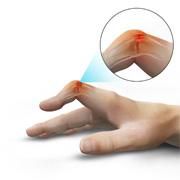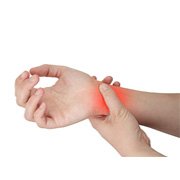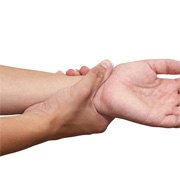- Anatomy
- Conditions
- Procedures
Pediatric Forearm Fracture

The healing of fractures in children is quicker than that in adults. Thus, if a fracture is suspected in a child, it is necessary to seek immediate medical attention for proper alignment of the bones. Forearm bones may break in many ways. Fractures may be “openâ€Â where the bone protrudes through the skin, or “closedâ€Â where the broken bone does not pierce the skin.
Wrist Fracture

The wrist is comprised of two bones in the forearm, the radius and ulna, and eight tiny carpal bones in the palm. The bones meet to form multiple large and small joints. A wrist fracture refers to a break in one or more of these bones.
Fractures of the Hand and Fingers

A fracture is a break in the bone, which occurs when force greater than the bearable limit is applied against a bone. The most common symptoms of any fracture include severe pain, swelling, bruising or bleeding, deformity and discoloration of the skin and limited mobility of the hand.
A finger fracture is not a minor injury, and if left untreated, can lead to stiffness, pain, disruption of the alignment of the whole hand and interference with specialized functions such as grasping or manipulating objects. Finger fractures commonly occur during sports activities, when you break a fall or while operating machinery.
Brachial Plexus Injury

A brachial plexus injury is a condition characterized by injury or damage to the brachial plexus, a network of nerves that emerges from the spinal cord in the neck region. The brachial plexus enables the movement of the muscles in the arms and shoulders and sensation in the overlying skin.
Wrist Sprain

Injuries caused due to stretching or tearing of the ligaments in the wrist are called wrist sprains. Sprains can range from mild to severe, based on the extent of injury to the ligament.
Wrist sprains are usually caused by a fall during daily activities or sports activities.
Flexor Tendon Injuries

Deep cuts on the under surface of the wrist, hand or fingers can cut and injure the tendon, and make it unable to bend one or more joints in a finger. When a tendon gets cut, the cut ends gets pulled away from each other like a rubber band.
Flexor tendon tears may be partial or complete. If tendons are completely cut through, the finger joints cannot bend on their own.
Mallet Finger

A mallet finger is a condition where the end of the finger is bent and does not straighten. Mallet finger occurs when the extensor tendon at the back of the finger is damaged.
Mallet finger occurs due to sports activities (such as baseball) or other activities that cause a direct and forceful impact on the fingers that jam the finger.
Finger Sprain

Injuries that involve tearing or stretching of the ligaments of your fingers are termed as sprains. Sprains in the fingers are most often caused from a fall when you extend your arms to reduce the impact of the fall, or from overuse or repetitive activity of the thumb such as with texting.
Ulnar Nerve Compression in Guyon’s Canal

Ulnar nerve compression in Guyon’s canal is a condition characterized by pain, numbness, weakness, and tingling sensation in the hand. The condition occurs when the ulnar nerve, the nerve that travels across the elbow from the shoulder to the hand, is compressed as it goes from the wrist into the hand through a space known as Guyon’s canal. Ulnar nerve damage stops or slows down signals that are being sent across the nerve to the hand.
Scaphoid Fracture

The scaphoid bone is a small, boat-shaped bone in the wrist, which, along with 7 other bones, forms the wrist joint. It is present on the thumb side of the wrist and is at high risk for fractures. A scaphoid fracture is usually seen in young men aged 20 to 30 years. They can occur at two places: near the thumb or near the forearm.
Finger Dislocation

Finger dislocation is a condition in which the bone of your finger has moved away from its normal position. Dislocation can be caused from jamming or overextending the finger during sports activities or a fall on an outstretched hand.
Distal Intersection Syndrome

Distal intersection syndrome also referred to as tenosynovitis of the radial wrist extensors is characterized by the radial wrist and forearm pain. Distal intersection syndrome is tenosynovitis of the third extensor compartment (extensor pollicis longus) where it crosses the second extensor compartment. It is different from intersection syndrome which is overuse tenosynovitis particularly of the second extensor compartment (extensor carpi radialis longus and extensor carpi radialis brevis) caused due to friction from the overlying first compartment tendons (abductor polllicis longus and extensor pollicis brevis). Athletics or activities that involve repetitive wrist flexion and extension leads to distal intersection syndrome.
Adult Forearm Fractures

The forearm is made up of 2 bones, namely, the radius and ulna. The primary function of your forearm is rotation i.e., the ability to turn your palm up and down. The fracture of the forearm affects the ability to rotate your arm, as well as bend and straighten the wrist and elbow. The breaking of the radius or ulna in the middle of the bone requires a strong force and is most commonly seen in adults. In most of the cases, both bones are broken during a forearm fracture.
Arthritis of the Hand and Wrist

Arthritis is an inflammatory condition of the joints. There are several types of arthritis and the most common type is osteoarthritis or wear-and-tear arthritis. Arthritis affects various joints in the body and the arthritis in the hand affects the joint at the base of the thumb. Arthritis may also affect the joints of other digits.
Forearm Fractures in Children

The radius (bone on the thumb side) and ulna (bone on the little-finger side) are the two bones of the forearm. Forearm fractures can occur near the wrist, near the elbow or in the middle of the forearm. Apart from this, the bones in children are prone to a unique injury known as a growth plate fracture. The growth plate, which is made of cartilage (flexible tissue) is present at the ends of the bones in children and helps in the determination of length and shape of the mature bone.
Arthritis of the Thumb

Arthritis is an inflammatory condition of the joints. There are several types of arthritis. The most common type is osteoarthritis or wear-and-tear arthritis that affects the joint at the base of the thumb. Thumb arthritis is more common in women than men, and usually occurs after the age of 40 years.
Boutonniere Deformity

Tendons in your fingers connect the finger bones to finger muscles and help bend and straighten the finger at the joint when the muscles contract. Boutonnière deformity is a condition in which a tendon injury to the middle joint of the finger results in the inability to straighten the affected finger.
Carpal Tunnel Syndrome

Carpal tunnel syndrome is a common, painful, progressive condition that is caused by compression of the median nerve at the wrist area.
The common symptoms of carpal tunnel syndrome include numbness and tingling sensation in all the fingers except the little finger, pain and burning sensation in your hand and wrist that may radiate up the arm and elbow, and weakness in your hand with diminished grip strength.
De Quervain’s Tendinosis

Inflammation and swelling of the tendon sheaths put pressure on the adjacent nerves and leads to pain and numbness in the thumb side of the wrist. Strain on these tendons can cause swelling and irritation, and lead to a condition called De Quervain's tenosynovitis, which is characterized by inflammation. The condition is also referred to as De Quervain’s tendinitis, De Quervain’s tendinosis, De Quervain’s syndrome or De Quervain’s disease.
Trigger Finger

Inflammation in the tenosynovium leads to a condition called trigger finger, also known as stenosing tenosynovitis or flexor tendonitis, where one of the fingers or thumb of the hand is caught in a bent position. The affected digit may straighten with a quick snap, like pulling and releasing the trigger on a gun, hence the name trigger finger.
Distal Radius Fracture

The forearm consists of two bones, the radius, and ulna. The radius is the larger of the two forearm bones. The region towards the wrist is called the distal end. Fractures in this end are most common.
The distal radius can get fractured in various ways, but it generally occurs around 1 inch from the distal end of the wrist. The most commonly occurring distal radius fracture is the Colles fracture, which is characterized by an upward tilting of the broken radius bone.
Hand Pain

The hand is composed of nerves, bones, blood vessels, muscles, tendons and skin. Each part has its specific function such as nerves transfer sensation, joints control movements, blood vessels maintain circulation, muscles provide motion, tendons anchor the muscles to the bones, and skin receives sensations.
Injury or inflammation of any of these structures, due to a disorder or disease condition, may produce hand pain. Even compression of the nerves supplying these structures may cause hand pain.
Trapeziometacarpal (TMC) Arthritis

Trapeziometacarapal (TMC) joint arthritis, also known as carpometacarpal (CMC) joint arthritis or basilar thumb arthritis or rhizarthrosis, is a common form of arthritis that affects the first carpometacarpal (trapeziometacarpal) joint of the thumb. It is an inflammatory condition characterized by gradual wearing away of the cartilaginous surface of the TMC joint and the bones rubbing against each other causing inflammation and pain. It occurs most commonly in middle-aged, elderly, and postmenopausal women.
Wrist Injuries

The wrist is a commonly injured joint in the body. Injuries can occur while lifting and carrying heavy objects, operating machinery, bracing against a fall, orduring sports.
Sports Injuries of the Hand and Wrist

Sports injuries are injuries that most commonly occur during sports and exercises. These injuries may result from accidents, poor training practices, and use of improper protective gear, lack of conditioning, and insufficient warm-up and stretching. Sports injuries may be either acute (sprains, fractures, tears) or chronic (tendonitis, overuse injury) injuries.
Carpal Instability

Carpal instability is the loss of alignment of the carpal bones and/or radioulnar joint. The wrist is a complex joint that connects the forearm to the hand and allows it to move. It consists of 8 small bones called carpals that articulate with two long bones of the forearm (radius and ulna). The joint is supported by ligaments, tendons, nerves, blood vessels and muscles that help in movement.
Bennett’s Fracture

Bennet’s fracture is a break at the base of the first metacarpal bone (thumb bone) that meets the wrist at the first carpometacarpal (CMC) joint. The hand is composed of 3 types of bones: carpals or wrist bones, metacarpals or long hand bones, and phalanges or finger bones. Metacarpals consist of five long bones that connect the carpals with the phalanges.
Bennett’s fracture is often displaced and is known as a two-piece fracture.
Upper Limb (Arm) Artery Disease

Upper limb (arm) artery disease is a condition where an artery between the chest and the hand is blocked and does not supply blood to the arms. The narrowing or blockage of the artery may be caused due to atherosclerosis (hardening of the arteries due to plaque build-up).
Scapholunate Dissociation

Scapholunate dissociation is the abnormal orientation or movement of the small bones of your wrist: the scaphoid and lunate, in relation to one another.
The scaphoid and lunate are 2 of the 8 carpal bones in your wrist and are stabilized by a scapholunate interosseous ligament. They help to maintain wrist stability and movement.
Triscaphoid Joint Arthritis

Arthritis is an inflammatory condition of one or more joints in your body. Triscaphoid joint arthritis is the localised pain and inflammation of the shared joint between the 3 carpal bones of your wrist. These bones are called scaphoid, trapezium, and trapezoid and are present at the base of your thumb.
Arthritis of the triscaphoid joint is also called Staphotrapeziotrapezoid or STT joint arthritis
Wrist Injuries and Conditions

Wrist injuries commonly occur due to falls or certain sports and activities that involve repetitive use or excessive stress or strain on the wrists. These include gymnastics, basketball, working on an assembly line, or typing. Some wrist conditions have no clear cause.
Hand Injuries and Conditions

The hand is made up of the wrist, palm, and fingers and consists of bones, joints, muscles, ligaments, tendons, and many blood vessels and nerves. It is one of the most flexible and useful parts of our body and can suffer injury due to overuse or trauma. The hand can also be affected by certain chronic medical conditions.
Wrist Pain

Wrist pain is defined as any ache or discomfort in the wrist. The wrist is comprised of two bones in the forearm, the radius and ulna, and eight tiny carpal bones in the palm. The bones meet to form multiple large and small joints. A trauma or injury to one or more of these bones results in wrist pain.
The wrist is a commonly injured joint in the body. Wrist pain may occur due to sprains and strains, arthritis, and fractures that can occur with lifting and carrying heavy objects, while operating machinery, bracing against a fall, or from sports-related injuries.
Triquetrolunate Instability

Triquetrolunate instability is the instability that takes place between the triquetrum or medial column and the lunate bones or the central column of the wrist. The triquetrum and the lunate comprise the ulnar side of the proximal carpal row at the wrist. This joint is supported by the lunotriquetral (LT) ligament.
Hand Tumors

Any abnormal lump or bump on the hand is considered a hand tumor. Hand tumors can occur on the skin as a mole or a wart, underneath the skin soft tissue or on the bone. Most hand tumors are benign (non-cancerous); however, they can also rarely be malignant (cancerous).
Distal Radioulnar Joint (DRUJ) Instability

Distal radioulnar joint instability is the abnormal orientation or movement of the radius and ulna bones at the wrist in relation to one another. Injury to the tendons, ligaments and/or muscles stabilizing the joint may cause partial or complete dislocation.
The articular surface of the radius bone referred to as the ulnar notch, and the head of the ulna bone form the distal radioulnar joint. A complex structure called the triangular fibrocartilage complex (TFCC) contributes to wrist stability.
Work Related Hand Injuries

The hand is one of the most flexible and useful parts of our body that assist us in most workplace activities. Hand injuries can range from minor cuts or burns to severe injuries.
Hand trauma at industries is often caused by machine or power tools due to improper handling, improper safety guards and operating the machine under the influence of drugs or alcohol.
Fingertip Injuries

A fingertip injury is a wound or damage caused to the most distal portion of the finger. It can be a crush, a sharp cut, a tear or a combination of these, and can result in damage to the skin, nail or nailbed, tendon, pulp, bone, and nerve endings. It is one of the most common injuries to the hand and may occur due to accidents at home, work, or play.
Neuromuscular Hand Conditions

Neuromuscular hand conditions refer to disorders of the hands that occur due to an injury or compression of the nerves in the hands or arms that impact the muscles. Neuromuscular hand conditions affect the normal functioning of one or both hands beginning with muscle weakness, pain, numbness, improper coordination, and may lead to paralysis if not treated quickly.
Wrist Ligament Tear and Instability

A ligament is a strong, flexible band of fibrous tissue. The wrist has many ligaments that help to keep the wrist bones in proper position providing stability to the joint. A torn ligament causes the wrist bones to move out of their position, which in turn leads to wrist instability as the sprained (torn) ligament can no longer support the wrist bones.




